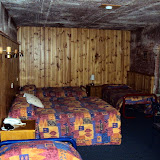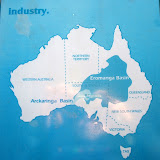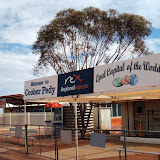 |
| Welcome to South Australia |
After watching the sunrise at Uluru, we headed to Coober Pedy, South Australia. This place is well known as the Opal Capital of the World; we also wanted to experience what makes this place unique in the world so we decided to stay at an underground hotel for one night. The rooms are very quiet and the weather outside was cold, but inside was very cosy and comfortable.
It is a very different place, it is surrounded by a lot of piles of sandstone dirt excavated from the mines; there is no other place like this one.....maybe there is: “Mars”.
The miners quickly discovered the advantages of living underground to escape the heat from the summer and winters cool desert nights. No matter how harsh the climate, the underground rooms maintain a comfortable temperature from 23-25 degrees day and night throughout the year.
It is estimated that about 50% of the population live underground; most dugout homes are excavated into hillsides rather than dug from shafts. We explored the town and visited churches, shops, hotels and bookshops, we even watched a documentary of the opals in an underground cinema; the experience was incredible and different.
 |
| Coober Pedy, SA |
 |
| Old Timers Mine Museum |
 |
| Underground Hotel |
We also went to the breakaways, it consists of colourful low hills, which have broken away from the Stuart Range, hence their name “the breakaways”; there are two lookouts which highlight the open spaces and colourful environment giving an impression of the long gone inland sea. This outcrop has been used in a number of films like “Mad Max” and “Ground Zero”.
Along the hills there is the dingo (wild dogs) fence, this 2 metres high wire barrier stretches for over 5,300 kilometres across three states to protect the sheep country in south from the dingoes.
 |
| Near by Coober Pedy |
We were highly recommended to do the flight and see the outback from the air. It was amazing to see the Australian desert, where you could see “nothing”; all we could see on the ground was red with little green patches.
Whilst on the flight we started to see more green patches and more green patches and suddenly the pilot pointed to us Lake Eyre, a 9600 sq km in size, which contains 400 million tonnes of salt and believe it or not it was a very big lake in the middle of the desert. We were told this lake was 80% full of its capacity and not seen like this in the last 34 years, most of this lake is 1 metre deep, with some 5 metre deep spots.
The flight continued and we landed at William Creek, located on the Oodnadatta track and it is South Australia’s smallest village with a population of 3 permanent residents, its main attraction being a bush pub, after a coldie at the pub we took off and headed to Anna Creek Station, which is the world’s largest cattle station, then we spotted Painted Hills, these hills form part of Anna Creek with 25000 square kilometres, and 60000 cattle heads. The painted hills are set on an area measuring 20 kilometres by 18 kilometres; it reveals pedestal rocks and sandstone hills of vividly coloured ochre-yellow oxide, red and deep brown with contrasting crisp whites and jet blacks. They say it’s a moon-like landscape.
 |
| Outback Scenic Flight |
After looking at the tracks from the air, Gabriel could not resist to do one of the most popular tracks in Australia, the Oonadatta Track and visit “The Pink Road House” or at least as far as we could, because some sections of the track have been closed due to heavy rain for several days and some opened 2 days ago, so up we went, surprisingly the track was very smooth, some sections were flooded, however we found there were detours to avoid damaging the track. The scenery was spectacular lots of beautiful wild flowers, shrubs, birds, so green, in fact it looked a lot nicer than from the air.
Suddenly we spotted a couple of camels on the road, when we approached them they were part of a wagon with a twist; one of the camels was pulling an unusual red vehicle attached by ropes, the other camel was just a companion. Then we had the opportunity to meet Klaus, he has a strong German accent even after migrating to Australia 40 years ago. He then introduced his two camels, named Willy and Snowy.
Klaus’ wagon is a cut down red Suzuki Van with rubber tyres; he was not happy because the solar panels did not charge the battery he uses to run his fridge and computer, because the sky was overcast; the number plate says “shit happens”. Klaus has been travelling around Australia for the past 16 years, first by bicycle and since 2002 accompanied by Willy and Snowy.
Klaus was very proud to talk about his new car, he said: “it is a lot better than the old Mitsubishi”, he prefers his car more than the push bike and enjoys travelling with his camels rather by himself.
 |
| Klaus and his camels |
After a quick stop at William Creek for lunch, we kept on driving and driving until we reached Anna Creek Station, we met some of the locals, had a soft drink and a nice chat regarding how they lived and worked in a very remote area, it was just amazing.
 |
| William Creek |
 |
| Anna Creek Station |
After saying good bye, we kept on driving until we reached Peake Station, this station is a little sister of Anna Creek Station, the only person we found told us everyone was working somewhere in the property and because they were so far away they were going to come back to the station by the end of the week. He told us they had enough food, water and their swags to last at least two weeks.
 |
| Peake Station |
Following our visit to this station we went back to the track and some kilometres later we found the track closed therefore we turned around and headed back towards William Creek, arriving at around 7 pm, we decided to have dinner at the pub and kept on going back to Coober Pedy, unbelievably we drove 600 kilometres.
Next day we headed to Port Augusta, South Australia, after our arrival, we had to try the local hotel (pub), very nice meal and atmosphere.
This town was the end our journey, however we could not resist leaving this region without a quick scenic drive (470 kilometres) through the Flinders Ranges, a semi-arid region of mountain ranges, magnificent scenery and endless colour changes. It was worth it because the amount of flowers, wildlife and spectacular views.
 |
| Flinders Ranges, SA |
Our trip to the Australian Outback was simply wonderful. We would like to thank all our followers for spending time reading and looking at the photos of our journey.
Australia is a beautiful country, it is very special, we enjoyed every place we visited, the roads we travelled, the towns, the pubs, the country side, the incredible desert, the culture, but moreover the very nice and friendly Australian people, always willing to help or simply have a chat.
Our only regret was that we didn’t have more time to explore further.
WE LOVE THIS COUNTRY !!!!
No comments:
Post a Comment